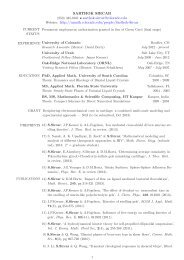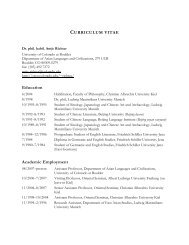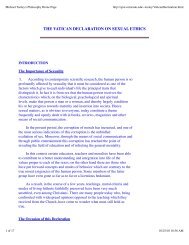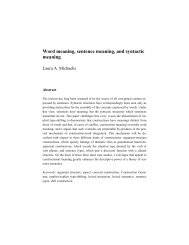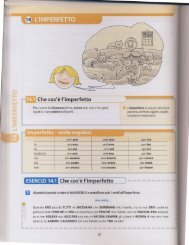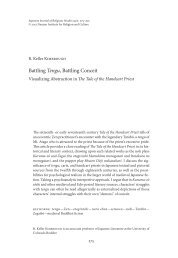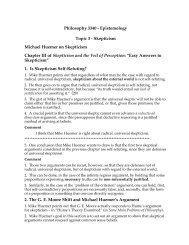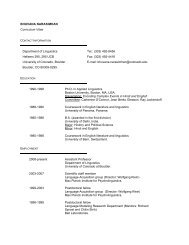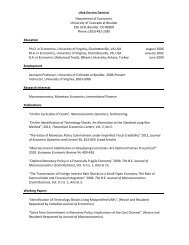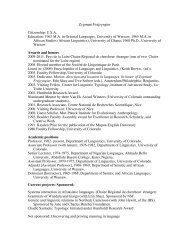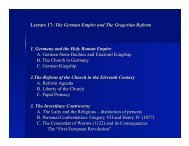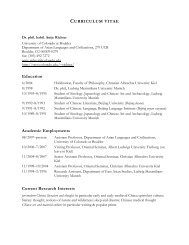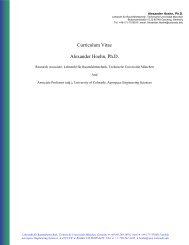8 Kant, Wittgenstein and the fate of analysis - spot
8 Kant, Wittgenstein and the fate of analysis - spot
8 Kant, Wittgenstein and the fate of analysis - spot
Create successful ePaper yourself
Turn your PDF publications into a flip-book with our unique Google optimized e-Paper software.
1 8 <strong>Kant</strong>, <strong>Wittgenstein</strong> <strong>and</strong> <strong>the</strong> <strong>fate</strong> <strong>of</strong><br />
2 <strong>analysis</strong><br />
3 Robert Hanna<br />
4 Philosophy ... is in fact <strong>the</strong> science <strong>of</strong> <strong>the</strong> relation <strong>of</strong> all cognition <strong>and</strong> <strong>of</strong> all use<br />
5 <strong>of</strong> reason to <strong>the</strong> ultimate end <strong>of</strong> human reason, to which, as <strong>the</strong> highest, all<br />
6 o<strong>the</strong>r ends are subordinated, <strong>and</strong> in which <strong>the</strong>y must all unite to form a unity.<br />
7 The field <strong>of</strong> philosophy in this cosmopolitan sense can be brought down to <strong>the</strong><br />
8 following questions: 1. What can I know? 2. What ought I to do? 3. What may I<br />
9 hope? 4. What is man? Metaphysics answers <strong>the</strong> first question, morals <strong>the</strong><br />
10 second, religion <strong>the</strong> third. Fundamentally, however, we could reckon all <strong>of</strong> this<br />
11 as anthropology, because <strong>the</strong> first three questions relate to <strong>the</strong> last one.<br />
12 (JL 9: 24–5)<br />
13 Philosophy is not a <strong>the</strong>ory but an activity.<br />
14 (TLP 4.112)<br />
15 What has to be accepted, <strong>the</strong> given, is – so one could say – forms <strong>of</strong> life.<br />
16 (PI 226e)<br />
17 In <strong>the</strong> light <strong>of</strong> a primary reason, an action is revealed as coherent with certain<br />
18 traits, long- or short-termed, <strong>of</strong> <strong>the</strong> agent, <strong>and</strong> <strong>the</strong> agent is shown in his role <strong>of</strong><br />
19 Rational Animal.<br />
20 (Donald Davidson) 1<br />
21 1 Introduction<br />
22 What is philosophical <strong>analysis</strong>? According to a highly influential conception<br />
23 dominant in <strong>the</strong> writings <strong>of</strong> Frege, Moore, Russell <strong>and</strong> <strong>Wittgenstein</strong> from<br />
24 <strong>the</strong> late 1870s to <strong>the</strong> mid-1920s, <strong>and</strong> which I will call <strong>the</strong> logical-decomposi-<br />
25 tional <strong>the</strong>ory <strong>of</strong> <strong>analysis</strong>,<br />
26 (1) analytic propositions are necessary a priori logical truths, <strong>and</strong><br />
27 (2) <strong>analysis</strong> is <strong>the</strong> process <strong>of</strong> (2.1) logically decomposing analytic proposi-<br />
28 tions 2 into metaphysical simples, which are mind-independently real yet<br />
29 immediately <strong>and</strong> infallibly apprehended with self-evidence, <strong>and</strong> <strong>the</strong>n (2.2)<br />
30 rigorously logically reconstructing those propositions by formal deduc-
146 Robert Hanna<br />
1 tion from (a) general logical laws <strong>and</strong> (b) premises that express logical<br />
2 definitional knowledge in terms <strong>of</strong> <strong>the</strong> simple constituents.<br />
3 As I will argue, <strong>the</strong> logical-decompositional <strong>the</strong>ory <strong>of</strong> <strong>analysis</strong> was impor-<br />
4 tantly negatively determined by <strong>the</strong> combined Fregean, Moorean, Russel-<br />
5 lian <strong>and</strong> especially early <strong>Wittgenstein</strong>ian rejection <strong>of</strong> what I will call <strong>Kant</strong>’s<br />
6 conceptual-decompositional <strong>the</strong>ory <strong>of</strong> <strong>analysis</strong> in <strong>the</strong> Critique <strong>of</strong> Pure Reason<br />
7 <strong>and</strong> <strong>the</strong> Jäsche Logic. At <strong>the</strong> same time however, <strong>the</strong> very idea <strong>of</strong> <strong>analysis</strong> as<br />
8 <strong>the</strong> process <strong>of</strong> logically decomposing an analytic proposition into its con-<br />
9 stituent parts, followed by a logical reconstruction <strong>of</strong> <strong>the</strong> same proposition,<br />
10 is shared by both <strong>the</strong>ories.<br />
11 But, as I will also argue, <strong>the</strong> later <strong>Wittgenstein</strong>’s devastating critique in<br />
12 <strong>the</strong> Philosophical Investigations <strong>of</strong> <strong>the</strong> doctrines <strong>of</strong> his own earlier philoso-<br />
13 phical self in <strong>the</strong> Tractatus Logico-Philosophicus motivates a radically wider<br />
14 <strong>and</strong> more open-textured conception <strong>of</strong> <strong>analysis</strong>. Indeed, <strong>Wittgenstein</strong>’s<br />
15 radical transformation <strong>of</strong> <strong>analysis</strong> returns us full circle to <strong>Kant</strong>’s notion <strong>of</strong><br />
16 philosophy, developed in <strong>the</strong> second half <strong>of</strong> <strong>the</strong> first Critique <strong>and</strong> in <strong>the</strong><br />
17 Introduction to his Logic, as a logically self-critical rational anthropology.<br />
18 This in turn provides us with a positive intimation <strong>of</strong> <strong>the</strong> nature <strong>of</strong> philo-<br />
19 sophical <strong>analysis</strong> in our so-called ‘post-analytic’ era.<br />
20 2 Conceptual <strong>analysis</strong>, <strong>the</strong> first Critique <strong>and</strong> transcendental idealism<br />
21 <strong>Kant</strong>’s <strong>the</strong>ory <strong>of</strong> <strong>analysis</strong> depends on his <strong>the</strong>ory <strong>of</strong> ‘concepts’ (Begriffe),<br />
22 which in turn depends on his <strong>the</strong>ory <strong>of</strong> mental ‘representation’ (Vorstellung).<br />
23 A concept is an essentially ‘mediate’ <strong>and</strong> ‘objective’ conscious mental<br />
24 representation (CPR A320/376–7). To say that a concept is objective is to<br />
25 say that it intrinsically has object-directedness or ‘aboutness’, <strong>and</strong> also that<br />
26 it is intersubjectively rationally communicable. So a concept is an abstract<br />
27 mental representation type with intrinsic intentionality, that also is tokened<br />
28 in many different conscious mental states. This is as opposed to merely<br />
29 ‘subjective’ mental representations, which may lack intentionality <strong>and</strong> which<br />
30 may occur in only one conscious mental state or (in a contingent way) pri-<br />
31 vately.<br />
32 To say that a concept is a mediate representation is to say that it repre-<br />
33 sents objects indirectly by means <strong>of</strong> intrinsically general descriptive attri-<br />
34 butes called ‘marks’ or ‘characteristics’ (Merkmale) (JL 9: 58). This is as<br />
35 opposed to an ‘intuition’ (Anschauung), which represents objects directly,<br />
36 singularly, <strong>and</strong> non-descriptively (CPR A320/377).<br />
37 O<strong>the</strong>rwise put, a concept is constituted by an ordered set <strong>of</strong> inherently<br />
38 general or universal marks or characteristics (CPR A25/B40) (JL 9: 58).<br />
39 This ordered set is an intensional ‘content’ or Inhalt, <strong>and</strong> corresponding to<br />
40 this intensional content is a cross-possible-worlds ‘extension’ or Umfang<br />
41 consisting <strong>of</strong> all <strong>the</strong> actual <strong>and</strong> possible objects that fall under that content<br />
42 by satisfying <strong>the</strong> descriptive criteria <strong>of</strong> <strong>the</strong> marks that constitute it (JL 9: 91,
1 95–6). Marks or characteristics are sub-concepts <strong>of</strong> <strong>the</strong> concept <strong>the</strong>y con-<br />
2 stitute. The ordering <strong>and</strong> structuring <strong>of</strong> <strong>the</strong> sub-concepts <strong>of</strong> a given concept<br />
3 is isomorphic to <strong>the</strong> ordering <strong>and</strong> structuring <strong>of</strong> concepts more generally<br />
4 (JL 9: 58–61, 95–9). Hence <strong>Kant</strong>’s <strong>the</strong>ory <strong>of</strong> <strong>the</strong> ordering <strong>and</strong> structuring <strong>of</strong><br />
5 concepts is also a <strong>the</strong>ory <strong>of</strong> conceptual microstructure. 3<br />
6 Even more precisely however, conceptual ordering on <strong>Kant</strong>’s scheme is<br />
7 ei<strong>the</strong>r vertical or horizontal.<br />
8 First, <strong>the</strong> vertical ordering. ‘Higher’ or superordinate concepts are deter-<br />
9 minables 4 <strong>and</strong> have broader extensions. ‘Lower’ or subordinate concepts are<br />
10 determinates <strong>of</strong> those determinables <strong>and</strong> have narrower extensions. Higher<br />
11 determinable concepts are contained in <strong>the</strong>ir lower determinate concepts,<br />
12 <strong>and</strong> lower determinate concepts are contained under <strong>the</strong>ir higher determin-<br />
13 able concepts. Thus <strong>the</strong> concept MALE is contained in <strong>the</strong> concept<br />
14 BACHELOR <strong>and</strong> <strong>the</strong> concept BACHELOR is contained under <strong>the</strong> concept<br />
15 MALE.<br />
16 And second, <strong>the</strong> horizontal ordering. Two or more concepts are coordi-<br />
17 nate if <strong>the</strong>y are both lower or determinate concepts <strong>of</strong> <strong>the</strong> same higher or<br />
18 determinable concept, but do not have identical extensions. At <strong>the</strong> limit,<br />
19 coordinate concepts do not share any members <strong>of</strong> <strong>the</strong>ir extensions. Thus<br />
20 MALE <strong>and</strong> UNMARRIED provide an example <strong>of</strong> partially overlapping<br />
21 coordinate concepts under HUMAN; <strong>and</strong> ADULT <strong>and</strong> NON-ADULT<br />
22 provide an example <strong>of</strong> exclusive coordinate concepts under HUMAN.<br />
23 Against this <strong>the</strong>oretical backdrop, a conceptual <strong>analysis</strong> for <strong>Kant</strong> is a<br />
24 ‘decomposition’ (Zergliederung) <strong>of</strong> that concept in <strong>the</strong> sense that it displays<br />
25 <strong>the</strong> internal ordering <strong>and</strong> structuring <strong>of</strong> <strong>the</strong> sub-concepts <strong>of</strong> a given concept:<br />
26 or o<strong>the</strong>rwise put, it displays that concept’s microstructure. Basically, <strong>the</strong><br />
27 idea is to treat <strong>the</strong> analysed concept or analys<strong>and</strong>um as <strong>the</strong> lowest deter-<br />
28 minate concept, <strong>and</strong> <strong>the</strong>n find a set <strong>of</strong> non-exclusive coordinate determin-<br />
29 ables that has exactly <strong>the</strong> same extension as <strong>the</strong> concept itself. Any two<br />
30 concepts, whe<strong>the</strong>r simple or complex, that share <strong>the</strong> same extension, <strong>Kant</strong><br />
31 calls ‘convertible’ or ‘reciprocal’ concepts (JL 9: 98), Thus an <strong>analysis</strong> <strong>of</strong><br />
32 BACHELOR yields<br />
33 < ADULT + UNMARRIED + MALE ><br />
The <strong>fate</strong> <strong>of</strong> <strong>analysis</strong> 147<br />
34 <strong>and</strong> <strong>the</strong> concepts BACHELOR <strong>and</strong> ADULT UNMARRIED MALE are<br />
35 convertible or reciprocal concepts.<br />
36 Each <strong>of</strong> <strong>the</strong> marks or characteristics belonging to <strong>the</strong> decomposable<br />
37 microstructure <strong>of</strong> a given concept is a constituent mark or characteristic <strong>of</strong><br />
38 that concept, in <strong>the</strong> sense that it is a proper <strong>and</strong> intrinsic part <strong>of</strong> <strong>the</strong> concept<br />
39 that it partially constitutes. The total set <strong>of</strong> such constituent marks or<br />
40 characteristics is thus a conceptual essence (JL 9: 60–1). Finding one or<br />
41 more <strong>of</strong> <strong>the</strong> constituent marks <strong>of</strong> a given concept is called giving an ‘expo-<br />
42 sition’ <strong>of</strong> that concept that also ‘expounds’ it (CPR A729/B757) (JL 9: 141–<br />
43 3). 5 Corresponding to each such expounding exposition is an analytic
148 Robert Hanna<br />
1 judgment in simple categorical form that predicates <strong>the</strong> constituent mark <strong>of</strong><br />
2 its given concept, because<br />
3 (1) <strong>the</strong> predicate-concept <strong>of</strong> <strong>the</strong> judgment is <strong>the</strong>reby contained in <strong>the</strong> sub-<br />
4 ject-concept,<br />
5 (2) <strong>the</strong> predicate concept is identical with at least one <strong>of</strong> <strong>the</strong> constituents<br />
6 (JL 9: 111), <strong>and</strong><br />
7 (3) <strong>the</strong> denial <strong>of</strong> that judgment entails a formal contradiction between <strong>the</strong><br />
8 negation <strong>of</strong> <strong>the</strong> predicate, <strong>and</strong> some constituent mark <strong>of</strong> <strong>the</strong> given con-<br />
9 cept (CPR A150–3/B189–93).<br />
10 Thus ‘Bachelors are adults’, ‘Bachelors are unmarried’, ‘Bachelors are<br />
11 males’, ‘Bachelors are unmarried adults’, ‘Bachelors are adult males’,<br />
12 ‘Bachelors are unmarried males’, <strong>and</strong> ‘Bachelors are adult unmarried males’<br />
13 are all analytic judgments that correspond to different expounding exposi-<br />
14 tions <strong>of</strong> <strong>the</strong> concept BACHELOR.<br />
15 A complete decomposition <strong>of</strong> a given concept yields an analytic definition<br />
16 <strong>of</strong> that concept (JL 9: 140–5). But <strong>Kant</strong> is both fully aware <strong>and</strong> also quite<br />
17 explicit that analytic definitions are very thin on <strong>the</strong> ground:<br />
18 Since one cannot become certain through any test whe<strong>the</strong>r one has<br />
19 exhausted all <strong>the</strong> marks <strong>of</strong> a given concept through a complete decom-<br />
20 position, all analytic definitions are held to be uncertain.<br />
21 (JL 9: 142)<br />
22 In fact, definitions are in general an ideal goal <strong>of</strong> <strong>analysis</strong> ra<strong>the</strong>r than a<br />
23 requirement <strong>of</strong> <strong>analysis</strong>. All that is required is an exposition or partial ana-<br />
24 lysis <strong>of</strong> any given concept: that is, all that is required is to find at least some<br />
25 <strong>of</strong> <strong>the</strong> constituent marks <strong>of</strong> any given concept. Indeed, <strong>the</strong> very supposition<br />
26 that one requires a complete <strong>analysis</strong> <strong>of</strong> a concept <strong>and</strong> <strong>the</strong>refore a definition<br />
27 <strong>of</strong> it, in order to be able to deploy it in philosophy or use it in ordinary<br />
28 reasoning <strong>and</strong> thought, is a fundamental philosophical error:<br />
29 Philosophy is swarming with mistaken definitions, especially those that<br />
30 actually contain elements for a definition but are not yet complete. If<br />
31 we could not make use <strong>of</strong> a concept until we had defined it, <strong>the</strong>n all<br />
32 philosophizing would be in a bad way.<br />
33 (CPR A731/B759 n.)<br />
34 As a consequence, conceptual-decompositional <strong>analysis</strong>, <strong>and</strong> along with<br />
35 it, <strong>the</strong> search for analytically necessary a priori truths – but not <strong>the</strong> search<br />
36 for definitions – is a crucial part <strong>of</strong> philosophy. For <strong>Kant</strong>, <strong>the</strong> primary goal<br />
37 <strong>of</strong> philosophy is to find, explain, justify <strong>and</strong> know principles, that is, fun-<br />
38 damental normative necessary a priori laws <strong>of</strong> nature, metaphysics, logic,<br />
39 morality <strong>and</strong> aes<strong>the</strong>tic experience (CPR B19, A50–A64/B74–B88, A148–62/
The <strong>fate</strong> <strong>of</strong> <strong>analysis</strong> 149<br />
1 B188–202, A836/B865) (CPJ 5: 286–7). These laws are normative because<br />
2 <strong>the</strong>y tell us, categorically, how we human animals ought to know scientifi-<br />
3 cally (Wissen), think, will, act <strong>and</strong> feel if we are also to be rational. Most <strong>of</strong><br />
4 <strong>the</strong>se principles are syn<strong>the</strong>tically necessary a priori, <strong>and</strong> not analytic.<br />
5 Never<strong>the</strong>less analytic truths, <strong>and</strong> in particular <strong>the</strong> laws <strong>of</strong> logic, are also<br />
6 amongst <strong>the</strong> principles.<br />
7 This is not to say that conceptual <strong>analysis</strong> can never be trivial, however. It<br />
8 is trivial if <strong>the</strong> <strong>analysis</strong> yields an exposition <strong>of</strong> a purely arbitrary or stipu-<br />
9 lative concept. For such concepts might fail to be objectively valid <strong>and</strong><br />
10 <strong>the</strong>reby fail to pick out real objects <strong>of</strong> actual or possible human experience<br />
11 (CPR A729/B757). And as we have seen, <strong>the</strong> search for a complete <strong>analysis</strong><br />
12 or definition can also lead to <strong>the</strong>oretical disaster. But assuming that <strong>the</strong><br />
13 concept is objectively valid, <strong>the</strong>n a partial conceptual <strong>analysis</strong>, i.e. <strong>the</strong> par-<br />
14 tial decomposition <strong>of</strong> a concept into its constituent marks, is an important<br />
15 <strong>and</strong> indeed necessary part <strong>of</strong> philosophy:<br />
16 But since, however far <strong>the</strong> elements (<strong>of</strong> <strong>the</strong> decomposition) reach, a<br />
17 good <strong>and</strong> secure use can always be made <strong>of</strong> <strong>the</strong>m, even imperfect defi-<br />
18 nitions, i.e., propositions that are not really definitions but are true <strong>and</strong><br />
19 thus approximations <strong>of</strong> <strong>the</strong>m, can be used with great advantage.<br />
20 (CPR A731/B759 n.)<br />
21 But why, more precisely, is conceptual <strong>analysis</strong> philosophically important<br />
22 <strong>and</strong> necessary? The <strong>Kant</strong>ian answer is that it tells us about <strong>the</strong> nature <strong>of</strong> <strong>the</strong><br />
23 concepts we can already effectively use but do not fully possess, in that it<br />
24 tells us about <strong>the</strong> fine-grained details <strong>of</strong> <strong>the</strong> microstructures <strong>of</strong> <strong>the</strong> several<br />
25 concepts in our existing conceptual repertoire:<br />
26 A great part, perhaps <strong>the</strong> greatest part, <strong>of</strong> <strong>the</strong> business <strong>of</strong> our reason<br />
27 consists in decompositions <strong>of</strong> <strong>the</strong> concepts we already have <strong>of</strong> objects.<br />
28 This affords us a multitude <strong>of</strong> cognitions that, though <strong>the</strong>y are nothing<br />
29 more than illuminations or clarifications <strong>of</strong> that which is already<br />
30 thought in our concepts (though still in a confused way), are, at least as<br />
31 far as <strong>the</strong>ir form is concerned, treasured as if <strong>the</strong>y were new insights,<br />
32 though <strong>the</strong>y do not extend <strong>the</strong> concepts that we have in ei<strong>the</strong>r matter or<br />
33 intensional content but only set <strong>the</strong>m apart from each o<strong>the</strong>r ... [T]his<br />
34 procedure does yield real a priori cognition, which makes secure <strong>and</strong><br />
35 useful progress.<br />
36 (CPR A5–6/B9–10)<br />
37 In short, conceptual <strong>analysis</strong> yields a crucial form <strong>of</strong> rational self-knowl-<br />
38 edge. For <strong>Kant</strong>, <strong>the</strong> conceptual <strong>analysis</strong> <strong>of</strong> objectively valid concepts does<br />
39 indeed tell us about humanly experienceable reality <strong>and</strong> <strong>the</strong> empirical world,<br />
40 but only indirectly <strong>and</strong> derivatively; more directly <strong>and</strong> originally, conceptual<br />
41 <strong>analysis</strong> is all about us as rational human animals.
150 Robert Hanna<br />
1 This raises a crucial point about <strong>Kant</strong>’s conception <strong>of</strong> <strong>analysis</strong>. It needs<br />
2 to be emphasized that focusing on conceptual <strong>analysis</strong> is a somewhat mis-<br />
3 leading way to present <strong>Kant</strong>’s Critical philosophy. The basic aim <strong>of</strong> <strong>the</strong><br />
4 Critical philosophy is to establish <strong>the</strong> doctrine <strong>of</strong> transcendental idealism.<br />
5 Well, what is transcendental idealism? The telegraphically short answer is<br />
6 that it is <strong>the</strong> doctrine which says that all knowable reality is anthropocentric.<br />
7 But here is a slightly less telegraphic answer. Transcendental idealism<br />
8 depends on a pre-<strong>the</strong>oretical brute fact – <strong>the</strong> brute fact that <strong>the</strong>re are<br />
9 inherent anthropocentric limitations on our capacity for reason. On <strong>the</strong><br />
10 cognitive side <strong>of</strong> our nature, human reason is sharply constrained by three<br />
11 special conditions <strong>of</strong> human sensibility: two formal conditions, namely <strong>the</strong><br />
12 necessary a priori representations <strong>of</strong> space <strong>and</strong> time (CPR A38–9/B55–6);<br />
13 <strong>and</strong> one material condition, namely affection, or <strong>the</strong> triggering <strong>of</strong> cognitive<br />
14 processes by <strong>the</strong> direct givenness <strong>of</strong> something existing outside <strong>the</strong> human<br />
15 cognitive faculty (CPR A19/B33). 6 Granting that, <strong>the</strong>n <strong>Kant</strong>’s transcenden-<br />
16 tal idealism, as <strong>the</strong> name suggests, is <strong>the</strong> conjunction <strong>of</strong> two sub-<strong>the</strong>ses: (i)<br />
17 <strong>the</strong> transcendentalism <strong>the</strong>sis, <strong>and</strong> (ii) <strong>the</strong> idealism <strong>the</strong>sis.<br />
18 (i) The transcendentalism <strong>the</strong>sis says that all <strong>the</strong> representational contents<br />
19 <strong>of</strong> cognition are strictly determined in <strong>the</strong>ir underlying forms or struc-<br />
20 tures by a set <strong>of</strong> underived, universal, innate, a priori human cognitive<br />
21 capacities, also known as ‘cognitive faculties’ (Erkenntnisvermögen). The<br />
22 whole system <strong>of</strong> cognitive capacities is constrained in its operations by<br />
23 both ‘pure general logic’ (<strong>the</strong> topic-neutral or ontically uncommitted, a<br />
24 priori, universal, <strong>and</strong> categorically normative science <strong>of</strong> <strong>the</strong> laws <strong>of</strong><br />
25 thought) <strong>and</strong> also by ‘transcendental analytic’ (which is pure general<br />
26 logic that is semantically <strong>and</strong> modally restricted by an explicit ontic<br />
27 commitment to <strong>the</strong> proper objects <strong>of</strong> human cognition) (CPR A50–7/<br />
28 B74–82).<br />
29 (ii) The idealism <strong>the</strong>sis says that <strong>the</strong> proper objects <strong>of</strong> human cognition are<br />
30 nothing but objects <strong>of</strong> our sensory experience – appearances or<br />
31 phenomena – <strong>and</strong> not things-in-<strong>the</strong>mselves or noumena, owing to <strong>the</strong><br />
32 fact that space <strong>and</strong> time are nothing but necessary subjective forms <strong>of</strong><br />
33 sensory intuition (<strong>Kant</strong> calls this <strong>the</strong> ‘ideality’ <strong>of</strong> space <strong>and</strong> time), toge-<br />
34 <strong>the</strong>r with <strong>the</strong> assumption that space <strong>and</strong> time are intrinsic structural<br />
35 properties <strong>of</strong> every object in space <strong>and</strong> time (CPR A19–49/B33–73,<br />
36 A369) (P 4: 293).<br />
37 Appearances, in turn, are token-identical with <strong>the</strong> intersubjectively com-<br />
38 municable contents <strong>of</strong> sensory or experiential representations (PC 11: 314).<br />
39 Correspondingly, <strong>the</strong> essential forms or structures <strong>of</strong> <strong>the</strong> appearances are<br />
40 type-identical with <strong>the</strong> representational forms or structures that are gener-<br />
41 ated by our universal innate a priori human mental faculties: ‘objects must<br />
42 conform (richten) to our cognition’ (CPR Bxvi), <strong>and</strong> ‘<strong>the</strong> object (as an
1 object <strong>of</strong> <strong>the</strong> senses) conforms to <strong>the</strong> constitution <strong>of</strong> our faculty <strong>of</strong> intuition’<br />
2 (CPR Bxvii).<br />
3 Putting transcendentalism <strong>and</strong> idealism toge<strong>the</strong>r, we now have <strong>the</strong> com-<br />
4 plex conjunctive <strong>Kant</strong>ian metaphysical <strong>the</strong>sis <strong>of</strong> transcendental idealism,<br />
5 capturing <strong>the</strong> fundamental idea that all knowable reality is anthropocentric:<br />
6 Human beings can cognize <strong>and</strong> know only ei<strong>the</strong>r sensory appearances<br />
7 or <strong>the</strong> forms or structures <strong>of</strong> those appearances – such that sensory<br />
8 appearances are token-identical with <strong>the</strong> contents <strong>of</strong> our objective sen-<br />
9 sory cognitions, <strong>and</strong> such that <strong>the</strong> essential forms <strong>and</strong> structures <strong>of</strong> <strong>the</strong><br />
10 appearances are type-identical with <strong>the</strong> representational forms or<br />
11 structures generated by our own cognitive faculties, especially <strong>the</strong><br />
12 intuitional representations <strong>of</strong> space <strong>and</strong> time – <strong>and</strong> <strong>the</strong>refore we can<br />
13 nei<strong>the</strong>r cognize, nor scientifically know, 7 nor even meaningfully assert<br />
14 or deny, anything about things-in-<strong>the</strong>mselves.<br />
15 (CPR A369, B310–11)<br />
16 Now what is <strong>the</strong> point <strong>of</strong> transcendental idealism? <strong>Kant</strong>’s answer to that<br />
17 question, which is worked out in <strong>the</strong> first Critique, is that transcendental<br />
18 idealism alone adequately explains how syn<strong>the</strong>tic a priori propositions – i.e.<br />
19 non-analytically, non-logically necessary, experience-independent truths –<br />
20 are semantically possible or objectively valid (CPR B19), <strong>and</strong> also how<br />
21 human freedom <strong>of</strong> <strong>the</strong> will, as a foundation <strong>of</strong> morality (where <strong>the</strong> o<strong>the</strong>r<br />
22 foundation is <strong>the</strong> Categorical Imperative, which in turn, as we learn in <strong>the</strong><br />
23 third section <strong>of</strong> <strong>the</strong> Groundwork <strong>of</strong> <strong>the</strong> Metaphysics <strong>of</strong> Morals <strong>and</strong> <strong>the</strong> Cri-<br />
24 tique <strong>of</strong> Practical Reason, necessarily <strong>and</strong> reciprocally implies real freedom<br />
25 <strong>of</strong> <strong>the</strong> will), is both logically <strong>and</strong> metaphysically possible (CPR Bxxv–xxx,<br />
26 A530–58/559–86).<br />
27 It should be clear enough now that whilst conceptual-decompositional<br />
28 <strong>analysis</strong> has an important <strong>and</strong> necessary role to play in <strong>Kant</strong>’s project <strong>of</strong><br />
29 transcendental idealism, it is also at best a subsidiary role. Analysis defers<br />
30 to anthropocentric metaphysics.<br />
31 3 Logical atomism, <strong>the</strong> Tractatus <strong>and</strong> solipsistic idealism<br />
The <strong>fate</strong> <strong>of</strong> <strong>analysis</strong> 151<br />
32 My historical hypo<strong>the</strong>sis is that analytic philosophy arose when, when, at<br />
33 <strong>the</strong> end <strong>of</strong> <strong>the</strong> nineteenth century,<br />
34 (1) <strong>Kant</strong>’s transcendental idealism <strong>and</strong> Hegel’s absolute idealism were alike<br />
35 rejected by <strong>the</strong> early analytic philosophers, who did this by proximally<br />
36 rejecting neo-<strong>Kant</strong>ianism <strong>and</strong> neo-Hegelianism, 8 <strong>and</strong> at <strong>the</strong> same time,<br />
37 (2) <strong>Kant</strong>’s conceptual-decompositional <strong>the</strong>ory <strong>of</strong> <strong>analysis</strong> was rejected <strong>and</strong><br />
38 replaced by <strong>the</strong> logical-decompositional <strong>the</strong>ory <strong>of</strong> <strong>analysis</strong>. 9
152 Robert Hanna<br />
1 To be sure, logical-decompositional <strong>analysis</strong> importantly refines <strong>the</strong> notion<br />
2 <strong>of</strong> a decomposition by<br />
3 (a) replacing <strong>the</strong> psychological notion <strong>of</strong> a concept with <strong>the</strong> logico-ma<strong>the</strong>-<br />
4 matical notion <strong>of</strong> a function, 10 <strong>and</strong><br />
5 (b) requiring <strong>the</strong> translation <strong>of</strong> natural language sentences into <strong>the</strong> canoni-<br />
6 cal notation <strong>of</strong> symbolic logic prior to <strong>the</strong> decomposition <strong>of</strong> <strong>the</strong> proposi-<br />
7 tions expressed by those sentences, in order to avoid logical confusions<br />
8 based on <strong>the</strong> misleading surface grammar <strong>of</strong> natural languages.<br />
9 But even after <strong>the</strong> rejection <strong>of</strong> both idealism <strong>and</strong> <strong>Kant</strong>’s conception <strong>of</strong><br />
10 <strong>analysis</strong>, <strong>the</strong> <strong>the</strong>sis that <strong>analysis</strong> is fundamentally decompositional remained<br />
11 firmly in place.<br />
12 The early analytic philosophers who carried out this philosophical revo-<br />
13 lution were <strong>of</strong> course Frege, Moore, Russell <strong>and</strong> <strong>the</strong> early <strong>Wittgenstein</strong>. And<br />
14 <strong>the</strong> revolution happened in stages. Frege created new <strong>and</strong> explicitly non-<br />
15 <strong>Kant</strong>ian conceptions <strong>of</strong> <strong>the</strong> analytic proposition <strong>and</strong> <strong>analysis</strong> that were<br />
16 designed to make possible <strong>the</strong> reduction <strong>of</strong> arithmetic to Fregean logic, <strong>and</strong><br />
17 to show that <strong>Kant</strong> was wrong that <strong>the</strong> truths <strong>and</strong> pro<strong>of</strong>s <strong>of</strong> arithmetic are<br />
18 syn<strong>the</strong>tic a priori. Moore replaced <strong>Kant</strong>ian concepts <strong>and</strong> judgments with<br />
19 mind-independent properties <strong>and</strong> propositions that could be directly intui-<br />
20 ted with self-evidence. Russell <strong>the</strong>n absorbed <strong>and</strong> extended both Frege’s<br />
21 logic <strong>and</strong> Moore’s metaphysics <strong>and</strong> epistemology, <strong>and</strong> produced <strong>the</strong> mature<br />
22 <strong>the</strong>ory <strong>of</strong> logical-decompositional <strong>analysis</strong> as <strong>the</strong> centrepiece <strong>of</strong> his general<br />
23 epistemological <strong>and</strong> metaphysical doctrine <strong>of</strong> logical atomism. 11 Finally, in<br />
24 <strong>the</strong> Tractatus, early <strong>Wittgenstein</strong> radically refined Russellian logical ato-<br />
25 mism <strong>and</strong> also definitively closed it as a philosophical programme.<br />
26 So how did <strong>the</strong> early <strong>Wittgenstein</strong> manage to do that? Answer: by means<br />
27 <strong>of</strong> <strong>the</strong> following (rationally reconstructed) basic argument.<br />
28 The basic argument <strong>of</strong> <strong>the</strong> Tractatus<br />
29 (1) The world, or reality, is <strong>the</strong> totality <strong>of</strong> facts, not things or objects<br />
30 (TLP 1.1).<br />
31 (2) The facts are in logical space (TLP 1.13, 2.013).<br />
32 (3) Facts are ei<strong>the</strong>r molecular (complex) or atomic (TLP 2.01, 2.0201).<br />
33 (4) Molecular facts logically reduce to atomic facts, which can be ei<strong>the</strong>r<br />
34 positive (existent) or negative (non-existent), <strong>and</strong> which are logically<br />
35 independent <strong>of</strong> one ano<strong>the</strong>r (TLP 2.034, 2.06, 2.0211).<br />
36 (5) Atomic facts logically reduce to configurations <strong>of</strong> objects (TLP<br />
37 2.0272).<br />
38 (6) Objects are absolute simples, which intrinsically possess both<br />
39 (i) ‘internal qualities’ that determine all <strong>the</strong> possible logical configura-<br />
40 tions <strong>of</strong> objects with o<strong>the</strong>r objects, <strong>and</strong>
The <strong>fate</strong> <strong>of</strong> <strong>analysis</strong> 153<br />
1 (ii) general logical forms, amongst which are space, time <strong>and</strong> colour<br />
2 (TLP 2.01231, 2.0124, 2.02, 2.0251).<br />
3 (7) Objects are represented (directly referred to) by names, <strong>and</strong> atomic<br />
4 facts are represented (pictured) by propositions, which are bipolar<br />
5 (T/F) truth-bearers <strong>and</strong> also <strong>the</strong> vehicles <strong>of</strong> sense (TLP 2.1–2.25).<br />
6 (8) Propositions are nothing but complex linguistic facts (complex sym-<br />
7 bols), <strong>and</strong> thus logically reduce to configurations <strong>of</strong> simple linguistic<br />
8 objects (simple symbols or names <strong>of</strong> objects, <strong>and</strong> logical constants)<br />
9 (TLP 3.1–3.3).<br />
10 (9) Unlike names <strong>of</strong> objects <strong>and</strong> atomic propositions, <strong>the</strong> logical con-<br />
11 stants do not represent (name or picture) (TLP 4.0312); instead <strong>the</strong>y<br />
12 show (non-representationally convey) <strong>the</strong> logical form <strong>of</strong> reality via<br />
13 propositions (TLP 4.12–4.121).<br />
14 (10) Thought (which includes judging, believing, asserting <strong>and</strong> statement-<br />
15 making) is nothing but <strong>the</strong> correct private use <strong>of</strong> propositional signs<br />
16 by a language-using subject (TLP 3.3–4.002).<br />
17 (11) Therefore <strong>the</strong> representing-relation between propositions <strong>and</strong> <strong>the</strong><br />
18 facts <strong>the</strong>y represent requires a representing <strong>and</strong> language-using sub-<br />
19 ject.<br />
20 (12) There is one <strong>and</strong> only one thinking <strong>and</strong> language-using subject, <strong>the</strong><br />
21 ego (TLP 5.62).<br />
22 (13) The ego is a non-psychological, metaphysical subject <strong>of</strong> thought <strong>and</strong><br />
23 language – a subject which is not a part <strong>of</strong> <strong>the</strong> world, but instead<br />
24 constitutes <strong>the</strong> limit <strong>of</strong> <strong>the</strong> world (TLP 5.6–5.62, 5.631–5.641).<br />
25 (14) The world depends both for its existence <strong>and</strong> also for <strong>the</strong> determi-<br />
26 nation <strong>of</strong> its nature on <strong>the</strong> metaphysical subject (TLP 5.621–5.63).<br />
27 (15) Logic is <strong>the</strong> a priori essence <strong>of</strong> thought, language, <strong>and</strong> <strong>the</strong> world<br />
28 (TLP 4.121, 5.552, 5.6–5.61, 6.124, 6.13).<br />
29 (16) Therefore logic explanatorily reduces to <strong>the</strong> metaphysical subject.<br />
30 (17) Therefore everything explanatorily reduces to <strong>the</strong> metaphysical sub-<br />
31 ject.<br />
32 In o<strong>the</strong>r words, if my reconstruction is correct, <strong>the</strong>n <strong>the</strong> Tractatus <strong>of</strong>fers us<br />
33 <strong>the</strong> most radical possible form <strong>of</strong> logical atomism, according to which <strong>the</strong>re<br />
34 is a logical reduction <strong>of</strong> everything to a single entity: a unique metaphysical<br />
35 subject. Logic is how <strong>the</strong> metaphysical subject cognitively expresses itself<br />
36 towards its world, <strong>and</strong> ethics is how <strong>the</strong> metaphysical subject non-cognitively<br />
37 expresses itself towards its world (TLP 6.4–6.522). This is <strong>Wittgenstein</strong>’s<br />
38 solipsistic idealism. It is <strong>of</strong> course beautifully ironic that although <strong>the</strong> ana-<br />
39 lytic tradition arose from <strong>the</strong> rejection <strong>of</strong> idealism, <strong>and</strong> although logical<br />
40 atomism was specifically designed to replace idealism, never<strong>the</strong>less <strong>the</strong> most<br />
41 radical form <strong>of</strong> logical atomism – Tractarian logical atomism – is itself a<br />
42 particularly radical form <strong>of</strong> idealism. 12<br />
43 In any case, against this radical metaphysical backdrop, early Wittgen-<br />
44 stein also develops a correspondingly radical conception <strong>of</strong> logical-decom-
154 Robert Hanna<br />
1 positional <strong>analysis</strong>. The proper targets <strong>of</strong> logical <strong>analysis</strong> are propositions.<br />
2 Logical <strong>analysis</strong> consists in completely <strong>and</strong> uniquely decomposing proposi-<br />
3 tional symbols into <strong>the</strong>ir constituent simple symbols, whe<strong>the</strong>r names <strong>of</strong><br />
4 objects or logical constants (TLP 3.23–3.261). Objects are known by direct<br />
5 cognitive acquaintance (TLP 2.0123–2.01231), <strong>and</strong> logical constants are<br />
6 known ‘transcendentally,’ or by means <strong>of</strong> a priori showing (TLP 4.12–<br />
7 4.1213). Every proposition has a unique <strong>and</strong> complete decomposition (TLP<br />
8 3.25). The way in which those names are configured into a propositional<br />
9 structure is made manifest through <strong>the</strong> process <strong>of</strong> <strong>analysis</strong> itself. Logical<br />
10 <strong>analysis</strong> is thus essentially a series <strong>of</strong> logical ‘elucidations’ (Erläuterungen).<br />
11 Again, logical <strong>analysis</strong> is essentially <strong>the</strong> activity (Tätigkeit) but not <strong>the</strong><br />
12 <strong>the</strong>ory (Lehre) <strong>of</strong> decomposing a proposition into its simple constituent<br />
13 symbols (TLP 4.112).<br />
14 This ‘activist’ conception <strong>of</strong> logical <strong>analysis</strong> has <strong>the</strong> significant virtue <strong>of</strong><br />
15 avoiding <strong>the</strong> Paradox <strong>of</strong> Analysis. According to <strong>the</strong> Paradox <strong>of</strong> Analysis, if<br />
16 an <strong>analysis</strong> is true <strong>the</strong>n it must be uninformative <strong>and</strong> trivial, because it is<br />
17 merely definitional <strong>and</strong> based on <strong>the</strong> identity <strong>of</strong> concepts; yet if an <strong>analysis</strong><br />
18 were non-trivial <strong>and</strong> informative, <strong>the</strong>n it would also be non-definitional <strong>and</strong><br />
19 entail <strong>the</strong> non-identity <strong>of</strong> concepts, hence false; so every <strong>analysis</strong> is ei<strong>the</strong>r<br />
20 trivial or false. But if <strong>analysis</strong> is essentially a logical activity <strong>and</strong> not a logi-<br />
21 cal <strong>the</strong>ory, <strong>the</strong>n strictly speaking an <strong>analysis</strong> is never true or false, so <strong>the</strong><br />
22 dilemma is avoided. Of course I am going very quickly here, <strong>and</strong> <strong>the</strong>re is<br />
23 much more to say about <strong>the</strong> Paradox <strong>of</strong> Analysis, its origins in Moore’s<br />
24 conception <strong>of</strong> <strong>analysis</strong>, <strong>and</strong> <strong>the</strong> many different attempts that have been<br />
25 made to solve it by appealing to various epistemic or semantic considera-<br />
26 tions. But we should note that <strong>Wittgenstein</strong>’s solution is striking precisely<br />
27 because it is non-cognitivist <strong>and</strong> non-semantic. By sharp contrast to both<br />
28 <strong>Wittgenstein</strong>’s solution <strong>and</strong> <strong>the</strong> o<strong>the</strong>r classical epistemic or semantic solu-<br />
29 tions, <strong>Kant</strong>’s own <strong>the</strong>ory <strong>of</strong> conceptual-decompositional <strong>analysis</strong> contains<br />
30 <strong>the</strong> elements <strong>of</strong> an interesting cognitive-semantic solution to <strong>the</strong> Paradox. 13<br />
31 In any case <strong>and</strong> more precisely, <strong>the</strong> Tractarian activist conception <strong>of</strong><br />
32 logical <strong>analysis</strong> has two basic parts <strong>and</strong> correspondingly two basic aims.<br />
33 First, <strong>the</strong> activity <strong>of</strong> <strong>analysis</strong> is a ‘critique <strong>of</strong> language’ (TLP 4.0031) in<br />
34 that it displays <strong>the</strong> fact that most propositions <strong>and</strong> questions that have been<br />
35 written about philosophical matters are not false but nonsensical (unsinnig)<br />
36 (TLP 4.003), recognizes that <strong>the</strong> analytic truths <strong>of</strong> logic are tautologous <strong>and</strong><br />
37 non-pictorial, hence ‘say nothing’ (sagen ...Nichts) (TLP 6.11), <strong>the</strong>n asserts<br />
38 as fully significant only <strong>the</strong> propositions <strong>of</strong> natural science (TLP 6.53), <strong>the</strong>n<br />
39 recognizes its own propositions as nonsensical, <strong>and</strong> finally ends in mystical<br />
40 silence (TLP 6.54). Thus <strong>the</strong> first basic aim <strong>of</strong> Tractarian logical <strong>analysis</strong> is<br />
41 to articulate <strong>the</strong> difference between sense (propositional meaningfulness)<br />
42 <strong>and</strong> nonsense (ei<strong>the</strong>r sheer meaninglessness, or else some essentially non-<br />
43 propositional form <strong>of</strong> meaningfulness).<br />
44 Second, <strong>the</strong> activity <strong>of</strong> logical <strong>analysis</strong> is <strong>the</strong> process <strong>of</strong> logically clarifying<br />
45 thoughts, consisting in a series <strong>of</strong> propositional elucidations which ‘make
The <strong>fate</strong> <strong>of</strong> <strong>analysis</strong> 155<br />
1 clear <strong>and</strong> delimit sharply <strong>the</strong> thoughts which o<strong>the</strong>rwise are ... opaque <strong>and</strong><br />
2 blurred’ (TLP 4.112). Thus <strong>the</strong> second basic aim <strong>of</strong> Tractarian logical ana-<br />
3 lysis is to reveal <strong>the</strong> deep or logico-grammatical structure <strong>of</strong> natural lan-<br />
4 guage <strong>and</strong> thought, as opposed to its merely surface or psychologico-<br />
5 grammatical structure. In order to reveal <strong>the</strong> deep structure <strong>of</strong> language,<br />
6 Tractarian philosophers must construct <strong>and</strong> study symbolic logical systems<br />
7 like those developed in <strong>the</strong> Begriffsschrift <strong>and</strong> Principia Ma<strong>the</strong>matica. Such<br />
8 symbolic systems are ‘ideal’ in <strong>the</strong> sense that <strong>the</strong> syntax <strong>of</strong> a Begriffsschrift-<br />
9 type notational system itself displays, encodes, or mirrors <strong>the</strong> deep structure<br />
10 <strong>of</strong> natural language <strong>and</strong> thought, <strong>and</strong> <strong>the</strong>reby also <strong>the</strong> deep structure <strong>of</strong> <strong>the</strong><br />
11 world <strong>of</strong> facts that language <strong>and</strong> thought represent. Even so, Tractarian<br />
12 <strong>analysis</strong> does not aim at <strong>the</strong> prescriptive reform <strong>of</strong> natural language or<br />
13 thought. On <strong>the</strong> contrary, everything in natural language <strong>and</strong> thought is<br />
14 perfectly in order, just as it is (TLP 5.5563).<br />
15 But here is <strong>the</strong> crucial point for our purposes. <strong>Kant</strong>’s conceptual-decom-<br />
16 positional <strong>the</strong>ory <strong>of</strong> <strong>analysis</strong> can now be rejected from a Tractarian point <strong>of</strong><br />
17 view, by saying that even if ordinary language <strong>and</strong> thought do not need to<br />
18 be reformed, never<strong>the</strong>less <strong>Kant</strong>ian conceptual-decompositional <strong>analysis</strong><br />
19 operates entirely at <strong>the</strong> level <strong>of</strong> <strong>the</strong> surface structure <strong>of</strong> natural language <strong>and</strong><br />
20 thought. <strong>Kant</strong>ian decompositional <strong>analysis</strong> is <strong>the</strong>refore at best superficial<br />
21 <strong>analysis</strong>:<br />
22 Does not my study <strong>of</strong> sign-language correspond to <strong>the</strong> study <strong>of</strong> thought<br />
23 processes which philosophers [e.g. <strong>Kant</strong>, Boole, Mill, etc.] held to be so<br />
24 essential to <strong>the</strong> philosophy <strong>of</strong> logic? Only <strong>the</strong>y got entangled for <strong>the</strong><br />
25 most part in unessential psychological investigations, <strong>and</strong> <strong>the</strong>re is an<br />
26 analogous danger for my method.<br />
27 (TLP 4.1121)<br />
28 In this way, <strong>the</strong> sub-conceptual simples, or constituent marks that are <strong>the</strong><br />
29 basic objects <strong>of</strong> conceptual-decompositional <strong>analysis</strong>, are at best relative<br />
30 psychological simples, not absolute real simples. By sharp contrast to Kan-<br />
31 tian <strong>analysis</strong>, <strong>the</strong>n, which remains at <strong>the</strong> level <strong>of</strong> anthropocentric appear-<br />
32 ances, Tractarian logical-decompositional <strong>analysis</strong> is deep or sublime<br />
33 <strong>analysis</strong> in that it establishes logical <strong>and</strong> epistemic contact with <strong>the</strong> objects<br />
34 that ‘form <strong>the</strong> substance <strong>of</strong> <strong>the</strong> world’ (TLP 2.021). 14 In <strong>Kant</strong>ian jargon,<br />
35 Tractarian logical-decompositional <strong>analysis</strong> is noumenal <strong>analysis</strong> <strong>of</strong> things-<br />
36 in-<strong>the</strong>mselves. For <strong>Kant</strong>, <strong>of</strong> course, <strong>the</strong>se objects are utterly unknowable<br />
37 even if barely thinkable, <strong>and</strong> <strong>the</strong> appropriate philosophical attitude towards<br />
38 <strong>the</strong>m is a radical agnosticism, bordering on outright eliminativism (CPR<br />
39 A235–60/B294–315). <strong>Wittgenstein</strong> himself later came to very much <strong>the</strong> same<br />
40 conclusion.
156 Robert Hanna<br />
1 4 The Investigations, <strong>the</strong> critique <strong>of</strong> logical <strong>analysis</strong>, <strong>and</strong> logic-as-<br />
2 grammar<br />
3 The Tractatus brings a definitive closure to logical atomism by pushing <strong>the</strong><br />
4 reductive project <strong>of</strong> logical-decompositional <strong>analysis</strong> to its limits. It expli-<br />
5 citly shows why <strong>Kant</strong>’s conceptual-decompositional <strong>the</strong>ory <strong>of</strong> <strong>analysis</strong> is<br />
6 inadequate, but it also implicitly shows <strong>the</strong> inadequacy <strong>of</strong> both logical ato-<br />
7 mism <strong>and</strong> <strong>the</strong> very idea <strong>of</strong> logical-decompositional <strong>analysis</strong>. Or at least this<br />
8 is how <strong>Wittgenstein</strong> himself came to regard <strong>the</strong> Tractatus by <strong>the</strong> time <strong>of</strong> <strong>the</strong><br />
9 Philosophical Investigations. Indeed, in <strong>the</strong> Investigations <strong>the</strong> later Wittgen-<br />
10 stein explicitly rejects <strong>and</strong> radically re-thinks his own Tractarian <strong>the</strong>ory <strong>of</strong><br />
11 logical <strong>analysis</strong>. 15<br />
12 So how does <strong>the</strong> later <strong>Wittgenstein</strong> manage to do that? Answer: he does it<br />
13 by means <strong>of</strong> <strong>the</strong> following (again, rationally reconstructed) three-stage<br />
14 argument:<br />
15 (i) he rejects <strong>the</strong> direct-referentialist semantics <strong>of</strong> <strong>the</strong> Tractatus,<br />
16 (ii) he rejects <strong>the</strong> picture <strong>the</strong>ory <strong>of</strong> meaning in <strong>the</strong> Tractatus, <strong>and</strong><br />
17 (iii) he <strong>of</strong>fers reasons for <strong>the</strong> philosophically liberating proposal that logic is<br />
18 really nothing but ‘grammar’.<br />
19 Let us now look more closely at <strong>the</strong> details.<br />
20 The rejection <strong>of</strong> direct-referentialist semantics<br />
21 (1) Direct-referentialism says that <strong>the</strong> meaning <strong>of</strong> a name (whe<strong>the</strong>r a sin-<br />
22 gular term or a general term) is nothing but <strong>the</strong> referent or bearer <strong>of</strong> <strong>the</strong><br />
23 name, that is, an object <strong>of</strong> some sort. (Assumption)<br />
24 (2) The ‘Augustinian’ language game (i.e. <strong>the</strong> primitive or ‘toy’ language) <strong>of</strong><br />
25 <strong>the</strong> Builders in PI xx2, 6, <strong>and</strong> 8 is a model <strong>of</strong> a direct-referentialist lan-<br />
26 guage.<br />
27 (3) It is manifest that not everything that is language has meaning in this<br />
28 way<br />
29 (PI x3), if only because <strong>the</strong> referring terms <strong>of</strong> <strong>the</strong> Builders’ language also<br />
30 function as orders (PI x18). In fact it is more correct to think <strong>of</strong> words as<br />
31 tools embedded in ‘language-games’ (i.e. rule-governed linguistic practices)<br />
32 <strong>and</strong> ‘forms <strong>of</strong> life’ (i.e. modes <strong>of</strong> individual human action <strong>and</strong> <strong>of</strong> social<br />
33 human interaction <strong>and</strong> transaction) <strong>and</strong> playing any number <strong>of</strong> roles rela-<br />
34 tive to different language games <strong>and</strong> forms <strong>of</strong> life, than to think <strong>of</strong> <strong>the</strong>m as<br />
35 playing a single decontextualized semantic role in <strong>the</strong> language (PI xx19–23,<br />
36 26–7).<br />
37 (4) In a direct-referentialist semantics, <strong>the</strong>re are two types <strong>of</strong> names: singular<br />
38 terms (e.g. proper names, demonstratives) <strong>and</strong> general terms. Individual<br />
39 objects are assigned to singular terms, <strong>and</strong> concepts or properties or
1 some o<strong>the</strong>r sort <strong>of</strong> universals are assigned to general terms. (Assump-<br />
2 tion)<br />
3 (5) Individual objects are assigned to singular terms by ostension (PI x6).<br />
4 Singular reference is <strong>the</strong>n best understood as ostensively attaching a label<br />
5 to a thing, i.e. dubbing it (PI x37).<br />
6 (6) But every ostension is open to many distinct possible interpretations (PI<br />
7 xx28–38), <strong>and</strong> only actual use will uniquely fix an interpretation.<br />
8 (7) Moreover, if <strong>the</strong> meaning <strong>of</strong> a singular term were just <strong>the</strong> bearer <strong>of</strong> <strong>the</strong><br />
9 name, <strong>the</strong>n whenever <strong>the</strong> bearer was destroyed, <strong>the</strong> meaning would be<br />
10 destroyed, which is absurd because it would make true negative existen-<br />
11 tials with singular terms into nonsense (PI x40).<br />
12 (8) So direct-referentialism about singular terms is false, <strong>and</strong> an appeal to<br />
13 use is <strong>the</strong> best overall way <strong>of</strong> explaining how singular terms have mean-<br />
14 ing. (From (1) – (7))<br />
15 (9) Direct-referentialism as applied to general terms requires <strong>the</strong> existence <strong>of</strong><br />
16 non-vague or definite concepts or properties or o<strong>the</strong>r universals.<br />
17 (Assumption)<br />
18 (10) But <strong>the</strong>re are no non-vague or definite concepts or properties or<br />
19 o<strong>the</strong>r universals, but ra<strong>the</strong>r only family resemblances or clusters <strong>of</strong><br />
20 partially overlapping notions with blurred or vague boundaries: see,<br />
21 e.g., <strong>the</strong> concept or property or o<strong>the</strong>r universal GAME (PI xx66–71).<br />
22 Only <strong>the</strong> actual use <strong>of</strong> <strong>the</strong> general term will disambiguate its mean-<br />
23 ing as a concept-word or predicate. Indeed, <strong>the</strong>re are no analytic<br />
24 definitions <strong>of</strong> general terms, but instead only our actual patterns <strong>of</strong><br />
25 application <strong>of</strong> <strong>the</strong>m (PI xx75–78).<br />
26 (11) So direct-referentialism about general terms is false, <strong>and</strong> an appeal<br />
27 to use is <strong>the</strong> best overall way <strong>of</strong> explaining <strong>of</strong> how general terms have<br />
28 meaning. (From (9) – (10))<br />
29 (12) Therefore, direct-referentialism more generally is false, <strong>and</strong> an<br />
30 appeal to use is <strong>the</strong> best overall way <strong>of</strong> explaining how names have<br />
31 meaning. (From (8) <strong>and</strong> (11))<br />
32 The rejection <strong>of</strong> <strong>the</strong> picture <strong>the</strong>ory <strong>of</strong> meaning<br />
The <strong>fate</strong> <strong>of</strong> <strong>analysis</strong> 157<br />
33 (1) The picture <strong>the</strong>ory <strong>of</strong> meaning says that <strong>the</strong> meaning <strong>of</strong> a sentence is<br />
34 nothing<br />
35 but ei<strong>the</strong>r a picture <strong>of</strong> an atomic fact or a truth-functional compound <strong>of</strong><br />
36 <strong>the</strong>se. (Tractarian assumption)<br />
37 (2) Atomic facts are composed <strong>of</strong> configurations <strong>of</strong> absolutely simple objects<br />
38 in isomorphic correspondence with <strong>the</strong> parts <strong>of</strong> <strong>the</strong> atomic proposition,<br />
39 which is a configuration <strong>of</strong> ‘real names’. (Tractarian assumption)<br />
40 (3) So <strong>the</strong> picture <strong>the</strong>ory presupposes that ‘real names’ in atomic proposi-<br />
41 tions st<strong>and</strong> for absolutely simple objects (PI x39). In this respect Russell’s<br />
42 logical atomism, <strong>the</strong> Tractatus <strong>and</strong> Plato’s Theaetetus have all captured<br />
43 <strong>the</strong> same basic idea (PI x46).
158 Robert Hanna<br />
1 (4) But what is an absolutely simple object? The problem is that macro-<br />
2 scopic objects apparently have no unique decomposition into simple<br />
3 parts (PI x47). And if we try to imagine a primitive language game that<br />
4 models <strong>the</strong> Tractarian picture <strong>the</strong>ory, we find <strong>the</strong> same lack <strong>of</strong> unique<br />
5 decomposition into simple parts (PI x48).<br />
6 (5) So <strong>the</strong>re are no absolutely simple objects, <strong>and</strong> <strong>the</strong> picture <strong>the</strong>ory is<br />
7 <strong>the</strong>refore false. (From (1) – (4))<br />
8 (6) But <strong>the</strong> language game <strong>of</strong> using factual propositions implies <strong>the</strong> constant<br />
9 semantic availability <strong>of</strong> simple objects <strong>of</strong> some sort, even across <strong>the</strong> dif-<br />
10 ference between existence <strong>and</strong> non-existence (PI xx50, 55).<br />
11 (7) Contrary to <strong>the</strong> picture <strong>the</strong>ory, <strong>the</strong>n, it seems to be a much better overall<br />
12 explanation <strong>of</strong> <strong>the</strong> semantic <strong>of</strong> factual propositions to say that <strong>the</strong><br />
13 ‘simple’ objects are in fact systems <strong>of</strong> paradigms or samples – hence only<br />
14 relatively simple objects – that belong strictly to <strong>the</strong> ‘instruments’ or<br />
15 technology <strong>of</strong> <strong>the</strong> particular language-game (say, <strong>of</strong> factual propositions<br />
16 about colours) that is in play (PI xx50–51).<br />
17 (8) In this way, even though <strong>the</strong> picture <strong>the</strong>ory is false, relativizing simple<br />
18 objects to language-games gives a better overall explanation <strong>of</strong> <strong>the</strong><br />
19 semantics <strong>of</strong> factual propositions, <strong>and</strong> thus an appeal to use is <strong>the</strong> best<br />
20 overall way <strong>of</strong> explaining how sentences have meaning. (From (5) – (7))<br />
21 (9) Therefore, <strong>the</strong>re must be a relativization <strong>of</strong> <strong>the</strong> ontology <strong>of</strong> atomic facts<br />
22 to language games (PI xx59–60), which also undermines <strong>the</strong> semantic<br />
23 realism <strong>of</strong> <strong>the</strong> picture <strong>the</strong>ory. (From (8))<br />
24 The liberating proposal that logic is really nothing but grammar<br />
25 (1) Frege, Russell <strong>and</strong> <strong>the</strong> author <strong>of</strong> <strong>the</strong> Tractatus all hold <strong>the</strong> <strong>the</strong>sis that<br />
26 logic is something ‘sublime’: universal, a priori, necessary <strong>and</strong> essential<br />
27 to everything in <strong>the</strong> empirical world, as well as essential to language,<br />
28 propositions <strong>and</strong> thought (PI xx89, 90, 92, 97).<br />
29 (2) Fur<strong>the</strong>rmore, logic is required to carry out a complete decompositional<br />
30 <strong>analysis</strong> <strong>of</strong> our forms <strong>of</strong> language, propositions, <strong>and</strong> thoughts, which<br />
31 reveals <strong>the</strong>ir ‘hidden’ ‘simple’ structures <strong>and</strong> constituents, that is, <strong>the</strong>ir<br />
32 decomposable essences (PI xx91–92).<br />
33 (3) This in turn implies that language, propositions, thought <strong>and</strong> <strong>the</strong> world<br />
34 all possess decomposable essences (PI xx93–96).<br />
35 (4) But in fact (a) every sentence in our language is in order just as it is, (b)<br />
36 vagueness (via <strong>the</strong> pervasive family resemblance nature <strong>of</strong> all concepts) is<br />
37 a constitutive feature <strong>of</strong> meaning, (c) language is essentially a spatio-<br />
38 temporal phenomenon, not something abstract, <strong>and</strong> (d) <strong>the</strong> essence <strong>of</strong><br />
39 language, proposition, thought <strong>and</strong> <strong>the</strong> world is something that ‘already<br />
40 lies open to view <strong>and</strong> that becomes surveyable by a rearrangement’ (PI<br />
41 xx92, 98–100, 108–109).
The <strong>fate</strong> <strong>of</strong> <strong>analysis</strong> 159<br />
1 (5) So nei<strong>the</strong>r language, nor propositions, nor thought, nor <strong>the</strong> world have<br />
2 hidden decomposable essences, <strong>and</strong> <strong>the</strong>refore <strong>the</strong> <strong>the</strong>sis that logic is sub-<br />
3 lime is false. (From (1) – (4))<br />
4 (6) Fur<strong>the</strong>rmore, <strong>the</strong> <strong>the</strong>sis that logic is sublime turns out to be only a<br />
5 methodological assumption we have unintentionally imposed upon <strong>the</strong><br />
6 phenomena, indeed nothing but an artifact <strong>of</strong> an idealized metaphysical<br />
7 ‘picture’ that lay hidden in our language <strong>and</strong> held us captive (PI xx101–<br />
8 108, 110–115).<br />
9 (7) On <strong>the</strong> contrary, however, ‘<strong>the</strong> philosophy <strong>of</strong> logic speaks <strong>of</strong> sentences<br />
10 <strong>and</strong> words in exactly <strong>the</strong> sense in which we speak <strong>of</strong> <strong>the</strong>m in ordinary life<br />
11 when we say, e.g., ‘‘Here is a Chinese sentence’’ or ‘‘No, that only looks<br />
12 like writing; it is actually an ornament’’ <strong>and</strong> so on’ (PI x108). That is: we<br />
13 can regard logic as purely descriptive or re-descriptive, not essentialist<br />
14 <strong>and</strong> a priorist; <strong>and</strong> ‘what we do is to bring words back from <strong>the</strong>ir meta-<br />
15 physical to <strong>the</strong>ir everyday use’ by asking ‘is <strong>the</strong> word ever actually used<br />
16 in this way in <strong>the</strong> language which is its original home’ (PI x116).<br />
17 (8) Therefore we should adopt <strong>the</strong> <strong>the</strong>sis that logic is really nothing but<br />
18 ‘grammar’, which ‘sheds light on our problem by clearing mis-<br />
19 underst<strong>and</strong>ings away ... misunderst<strong>and</strong>ings concerning <strong>the</strong> use <strong>of</strong> words,<br />
20 caused, among o<strong>the</strong>r things by certain analogies between <strong>the</strong> forms <strong>of</strong><br />
21 expression in different regions <strong>of</strong> language ... [<strong>and</strong>] some <strong>of</strong> <strong>the</strong>m can be<br />
22 removed by substituting one form <strong>of</strong> expression for ano<strong>the</strong>r; this may be<br />
23 called an ‘‘<strong>analysis</strong>’’ <strong>of</strong> our forms <strong>of</strong> expression, for <strong>the</strong> process is some-<br />
24 times like one <strong>of</strong> taking things apart’ (PI x90). For an example <strong>of</strong> this,<br />
25 see <strong>the</strong> discussion <strong>of</strong> negation at PI xx547–557. (From (5) – (7))<br />
26 (9) Fur<strong>the</strong>rmore, <strong>the</strong> goal <strong>of</strong> logic or grammar is to produce a ‘perspicuous<br />
27 representation’ <strong>of</strong> language, proposition, thought, <strong>and</strong> world, which<br />
28 produces ‘that underst<strong>and</strong>ing which consists in ‘‘seeing connections’’’ (PI<br />
29 x122).<br />
30 (10) So logic is not sublime, <strong>and</strong> logical <strong>analysis</strong> as logical-decomposi-<br />
31 tional <strong>analysis</strong> is impossible, but logic-as-grammar is possible, <strong>and</strong><br />
32 grammar in this sense is <strong>the</strong> descriptive logic <strong>of</strong> our language games,<br />
33 as embedded in our forms <strong>of</strong> life. And to <strong>the</strong> extent that logic as a<br />
34 <strong>the</strong>ory <strong>of</strong> valid reasoning still exists in logic-as-grammar, this logic is<br />
35 strongly non-classical. 16 (From (8) – (9))<br />
36 If <strong>Wittgenstein</strong>’s argument against <strong>the</strong> sublimity <strong>of</strong> logic is sound, <strong>the</strong>n<br />
37 logical <strong>analysis</strong> is impossible. So what, more precisely, does philosophical<br />
38 <strong>analysis</strong> become after <strong>the</strong> collapse <strong>of</strong> logical <strong>analysis</strong>? Answer: that is a very<br />
39 good question, whose answer we will need to approach in two stages.<br />
40 First, <strong>Wittgenstein</strong>’s later conception <strong>of</strong> philosophical <strong>analysis</strong> in fact<br />
41 shares some fundamental features in common with his activist conception<br />
42 <strong>of</strong> <strong>analysis</strong> in <strong>the</strong> Tractatus. But this activist conception <strong>of</strong> <strong>analysis</strong> is now<br />
43 minus <strong>the</strong> sublimity <strong>of</strong> logic, that is to say, minus <strong>the</strong> comprehensive noume-<br />
44 nal metaphysical picture <strong>of</strong> logic, language, thought <strong>and</strong> <strong>the</strong> world that
160 Robert Hanna<br />
1 would justify <strong>the</strong> logical-decompositional <strong>the</strong>ory <strong>of</strong> <strong>analysis</strong>. Here are some<br />
2 relevant texts describing this new form <strong>of</strong> philosophical <strong>analysis</strong>:<br />
3 Philosophy is a battle against <strong>the</strong> bewitchment <strong>of</strong> our intelligence by<br />
4 means <strong>of</strong> language.<br />
5 (PI x109)<br />
6 The results <strong>of</strong> philosophy are <strong>the</strong> uncovering <strong>of</strong> one or ano<strong>the</strong>r piece <strong>of</strong><br />
7 plain nonsense <strong>and</strong> <strong>of</strong> bumps that <strong>the</strong> underst<strong>and</strong>ing has got by run-<br />
8 ning its head up against <strong>the</strong> limits <strong>of</strong> language.<br />
9 (PI x119)<br />
10 A philosophical problem has <strong>the</strong> form: ‘I don’t know my way about’.<br />
11 (PI x123)<br />
12 Philosophy may in no way interfere with <strong>the</strong> actual use <strong>of</strong> language; it<br />
13 can in <strong>the</strong> end only describe it. For it cannot give it any foundation<br />
14 ei<strong>the</strong>r. It leaves everything as it is.<br />
15 (PI x124)<br />
16 The civil status <strong>of</strong> a contradiction, or its status in civil life: <strong>the</strong>re is <strong>the</strong><br />
17 philosophical problem.<br />
18 (PI x125)<br />
19 Philosophy simply puts everything before us, <strong>and</strong> nei<strong>the</strong>r explains nor<br />
20 deduces anything. Since everything lies open to view, <strong>the</strong>re is nothing to<br />
21 explain. For what is hidden, for example, is <strong>of</strong> no interest to us. One<br />
22 might give <strong>the</strong> name ‘philosophy’ to what is possible before all new<br />
23 discoveries <strong>and</strong> inventions.<br />
24 (PI x126)<br />
25 The work <strong>of</strong> <strong>the</strong> philosopher consists in assembling reminders for a<br />
26 particular purpose.<br />
27 (PI x127)<br />
28 If one tried to advance <strong>the</strong>ses in philosophy, it would never be possible<br />
29 to question <strong>the</strong>m, because everyone would agree to <strong>the</strong>m.<br />
30 (PI x128)<br />
31 It is not our aim to refine or complete <strong>the</strong> system <strong>of</strong> rules for <strong>the</strong> use <strong>of</strong><br />
32 words in unheard-<strong>of</strong> ways. For <strong>the</strong> clarity that we are aiming at is<br />
33 indeed complete clarity. But that simply means that <strong>the</strong> philosophical<br />
34 problems should completely disappear. The real discovery is one that<br />
35 makes me capable <strong>of</strong> stopping doing philosophy when I want to. The<br />
36 one that gives philosophy peace, so that it is no longer tormented by
The <strong>fate</strong> <strong>of</strong> <strong>analysis</strong> 161<br />
1 questions which bring itself into question ... There is not a philoso-<br />
2 phical method, though <strong>the</strong>re are indeed methods, like different <strong>the</strong>ra-<br />
3 pies.<br />
4 (PI x133)<br />
5 We are not analysing a phenomenon (e.g. thought) but a concept (e.g.<br />
6 that <strong>of</strong> thinking), <strong>and</strong> <strong>the</strong>refore <strong>the</strong> use <strong>of</strong> a word.<br />
7 (PI x383)<br />
8 In philosophy we do not draw conclusions. ‘But it must be like this!’ is<br />
9 not a philosophical proposition. Philosophy only states what everyone<br />
10 admits.<br />
11 (PI x599)<br />
12 With an eye to <strong>the</strong> next section, I will call this dialectical conceptual ana-<br />
13 lysis, where, as in <strong>Kant</strong>’s sense, ‘dialectic’ means <strong>the</strong> logical critique <strong>of</strong><br />
14 metaphysical illusion in philosophy, as a form <strong>of</strong> rational self-knowledge (CPR<br />
15 A61–2/B85–6, A293–8/B349–54). The main idea is that by deploying a<br />
16 strongly non-classical logic, <strong>the</strong> later <strong>Wittgenstein</strong>ian philosophical analyst<br />
17 or logical grammarian<br />
18 (a) displays <strong>and</strong> diagnoses <strong>the</strong> dialectical structure <strong>of</strong> philosophical pro-<br />
19 blems,<br />
20 (b) describes, unpacks, compares <strong>and</strong> contrasts <strong>the</strong> concepts implicit in our<br />
21 various ordinary uses <strong>of</strong> language <strong>and</strong> states truisms about <strong>the</strong>m, <strong>and</strong> <strong>the</strong>n<br />
22 (c) stops.<br />
23 Second, <strong>the</strong> o<strong>the</strong>r crucial thing about <strong>Wittgenstein</strong>’s later conception <strong>of</strong><br />
24 philosophical <strong>analysis</strong> is that it is fundamentally non-cognitive, that is, fun-<br />
25 damentally normative <strong>and</strong> practical. On this view, philosophy is nei<strong>the</strong>r a<br />
26 science nor indeed in any sense a source <strong>of</strong> factual knowledge but ra<strong>the</strong>r<br />
27 essentially a self-conscious <strong>and</strong> deliberate act – hence we can call it ‘doing<br />
28 philosophy’ – whose aim is seeing crosswise but not decompositional con-<br />
29 ceptual connections, 17 <strong>and</strong> finally achieving perspicuous insight into what<br />
30 already is completely <strong>the</strong>re already in front <strong>of</strong> us: human beings <strong>and</strong> <strong>the</strong>ir<br />
31 linguistic activities in <strong>the</strong>ir human world, that is, forms <strong>of</strong> human life:<br />
32 So you are saying that human agreement decides what is true <strong>and</strong> what<br />
33 is false? – It is what human beings say that is true <strong>and</strong> false; <strong>and</strong> <strong>the</strong>y<br />
34 agree in <strong>the</strong> language <strong>the</strong>y use. That is not agreement in opinions but in<br />
35 form <strong>of</strong> life.<br />
36 (PI x241)<br />
37 This linguistic agreement in form <strong>of</strong> life, in turn, is given essentially in <strong>the</strong><br />
38 activity <strong>of</strong> making judgments:
162 Robert Hanna<br />
1 If language is to be a means <strong>of</strong> communication <strong>the</strong>re must be agreement<br />
2 not only in definitions but also (queer as this may sound) in judgments.<br />
3 This seems to abolish logic, but does not do so.<br />
4 (PI x242)<br />
5 In o<strong>the</strong>r words: our linguistic agreement in form <strong>of</strong> life consists in our<br />
6 shared capacity for logical <strong>and</strong> practical reasoning. Thus <strong>the</strong> aim <strong>of</strong> philoso-<br />
7 phical <strong>analysis</strong> for <strong>the</strong> later <strong>Wittgenstein</strong> is to achieve insight into <strong>the</strong><br />
8 human agent qua Judging Animal. 18<br />
9 5 <strong>Kant</strong>, <strong>Wittgenstein</strong> <strong>and</strong> <strong>analysis</strong> as rational anthropology<br />
10 To summarize <strong>the</strong> conclusion <strong>of</strong> <strong>the</strong> last section: for <strong>the</strong> later <strong>Wittgenstein</strong>,<br />
11 philosophical <strong>analysis</strong> is <strong>the</strong> logically guided study <strong>of</strong> human beings inher-<br />
12 ently constrained in <strong>the</strong>ir individual intentional actions <strong>and</strong> social practices<br />
13 by self-legislated <strong>and</strong> communally constituted normative rules <strong>of</strong> judgment<br />
14 <strong>and</strong> language-use. Here <strong>the</strong> logical <strong>the</strong>ory, or logic-as-grammar, that guides<br />
15 later <strong>Wittgenstein</strong>ian <strong>analysis</strong> is not a classical logic but instead a strongly<br />
16 non-classical logic allowing for multiple conclusions, a denial <strong>of</strong> <strong>the</strong> princi-<br />
17 ple <strong>of</strong> excluded middle, a denial <strong>of</strong> two-valuedness or bivalence, ‘true con-<br />
18 tradictions’ or paradoxes, vagueness or borderline cases, irreducibly<br />
19 normative inferences, irreducible intensionality <strong>and</strong> various irreducible<br />
20 intentional propositional attitudes. This does not mean that anything goes:<br />
21 logic-as-grammar is still strictly normatively guided by some conception or<br />
22 ano<strong>the</strong>r <strong>of</strong> logical consequence; <strong>and</strong> not every proposition is both true <strong>and</strong><br />
23 false. 19<br />
24 Perhaps even more importantly, later <strong>Wittgenstein</strong>’s strongly non-classical<br />
25 logic bears an essential similarity to what <strong>Kant</strong> called ‘transcendental logic’,<br />
26 which includes both transcendental analytic (<strong>the</strong> logic <strong>of</strong> truth) <strong>and</strong> trans-<br />
27 cendental dialectic (<strong>the</strong> logic <strong>of</strong> illusion). The salient difference between<br />
28 <strong>Kant</strong> <strong>and</strong> <strong>Wittgenstein</strong> is that later <strong>Wittgenstein</strong>’s logic-as-grammar expli-<br />
29 citly incorporates <strong>the</strong> total range <strong>of</strong> facts encompassing human linguistic<br />
30 competence <strong>and</strong> linguistic performance within its scope, whereas this incor-<br />
31 poration is at best implicit for <strong>Kant</strong>. 20<br />
32 But <strong>the</strong> crucial point is that <strong>the</strong> later <strong>Wittgenstein</strong>’s conception <strong>of</strong> philo-<br />
33 sophical <strong>analysis</strong> has a fundamental affinity with <strong>Kant</strong>’s conception <strong>of</strong> phi-<br />
34 losophy as it is worked out in <strong>the</strong> Transcendental Doctrine <strong>of</strong> Method.<br />
35 There <strong>Kant</strong> tells us that philosophy is <strong>the</strong> study <strong>of</strong> rational human cogni-<br />
36 tion. Rational human cognition, in turn, is cognition from principles, which<br />
37 are <strong>the</strong> fundamental normative necessary a priori laws <strong>of</strong> scientific knowing,<br />
38 thought, volition, action <strong>and</strong> feeling. The fundamental normative necessary<br />
39 a priori laws <strong>of</strong> scientific knowing are <strong>the</strong> syn<strong>the</strong>tic a priori laws <strong>of</strong> nature<br />
40 <strong>and</strong> <strong>the</strong> syn<strong>the</strong>tic a priori laws <strong>of</strong> transcendental metaphysics. The funda-<br />
41 mental normative necessary a priori laws <strong>of</strong> thought are <strong>the</strong> analytic a priori<br />
42 laws <strong>of</strong> logic. The fundamental normative necessary a priori normative laws
The <strong>fate</strong> <strong>of</strong> <strong>analysis</strong> 163<br />
1 <strong>of</strong> volition <strong>and</strong> action are <strong>the</strong> laws <strong>of</strong> human morality. And for <strong>Kant</strong> <strong>the</strong>re<br />
2 is even a fundamental normative necessary a priori law <strong>of</strong> aes<strong>the</strong>tic experi-<br />
3 ence, or a ‘principle <strong>of</strong> taste’ (CPJ 5: 286–7).Thus philosophy for <strong>Kant</strong> is<br />
4 rational anthropology: <strong>the</strong> study <strong>of</strong> human beings ins<strong>of</strong>ar as <strong>the</strong>ir scientific<br />
5 knowing, thought, volition, action <strong>and</strong> feeling are governed <strong>and</strong> evaluable<br />
6 by principles. This does not <strong>of</strong> course imply that rational human animals<br />
7 ever actually manage to conform perfectly or even terribly adequately to<br />
8 <strong>the</strong>se principles. Rationality is <strong>the</strong> recognition <strong>of</strong> principles <strong>and</strong> <strong>the</strong> capacity<br />
9 to conform to <strong>the</strong>m freely, not actually conforming to <strong>the</strong>m. Indeed, only a<br />
10 rational animal who recognizes principles <strong>and</strong> has <strong>the</strong> capacity to conform<br />
11 to <strong>the</strong>m freely would ever be capable <strong>of</strong>, or even remotely interested in,<br />
12 trying to rationalize his way out <strong>of</strong> his responsibility for actually failing to<br />
13 match up to <strong>the</strong> principles that strictly obligate him.<br />
14 In this way, for both <strong>Kant</strong> <strong>and</strong> <strong>the</strong> later <strong>Wittgenstein</strong> alike, philosophical<br />
15 <strong>analysis</strong> construed as ei<strong>the</strong>r conceptual or logical decomposition is ulti-<br />
16 mately superseded by a deeper <strong>and</strong> essentially normative picture <strong>of</strong> <strong>analysis</strong>,<br />
17 as <strong>the</strong> logic <strong>of</strong> rational human activity. More precisely, according to this<br />
18 picture, <strong>analysis</strong> is <strong>the</strong> logical reconstruction <strong>of</strong> what Davidson calls ‘pri-<br />
19 mary reasons’ for <strong>the</strong> rationalization <strong>of</strong> individual human actions <strong>and</strong> <strong>of</strong><br />
20 social human interactions <strong>and</strong> transactions, including linguistic competence<br />
21 <strong>and</strong> performance. These primary reasons are logical interpretations <strong>of</strong> what<br />
22 human agents actually do:<br />
23 When we ask why someone acted as he did, we want to be provided<br />
24 with an interpretation ... When we learn his reason, we have an inter-<br />
25 pretation, a new description <strong>of</strong> what he did which fits it into a familiar<br />
26 picture ... To learn, through learning <strong>the</strong> reason, that <strong>the</strong> agent con-<br />
27 ceived his action as a lie, a repayment <strong>of</strong> a debt, an insult, <strong>the</strong> fulfilment<br />
28 <strong>of</strong> an avuncular obligation, or a knight’s gambit is to grasp <strong>the</strong> point <strong>of</strong><br />
29 <strong>the</strong> action in its setting <strong>of</strong> rules, practices, conventions <strong>and</strong> expectations.<br />
30 Remarks like <strong>the</strong>se, inspired by <strong>the</strong> later <strong>Wittgenstein</strong>, have been ela-<br />
31 borated with subtlety <strong>and</strong> insight by a numbers <strong>of</strong> philosophers. And<br />
32 <strong>the</strong>re is no denying that this is true: when we explain an action, by<br />
33 giving a reason, we do redescribe <strong>the</strong> action; redescribing <strong>the</strong> action<br />
34 gives <strong>the</strong> action a place in a pattern, <strong>and</strong> in this way <strong>the</strong> action is<br />
35 explained. 21<br />
36 Now as we have seen <strong>the</strong> logic guiding this reconstruction or interpretation<br />
37 <strong>of</strong> human actions, interactions <strong>and</strong> transactions is at once <strong>Kant</strong>’s transcen-<br />
38 dental logic <strong>and</strong> also <strong>Wittgenstein</strong>’s logic-as-grammar. So for <strong>Kant</strong> <strong>and</strong> <strong>the</strong><br />
39 later <strong>Wittgenstein</strong>, philosophical <strong>analysis</strong> is ultimately rational anthro-<br />
40 pology in a wide sense that includes <strong>the</strong> <strong>the</strong>ory <strong>of</strong> language: <strong>the</strong> logically<br />
41 guided universal normative <strong>the</strong>ory <strong>of</strong> human rationality. 22<br />
42 One last remark. In my opinion, this <strong>Kant</strong>ian <strong>and</strong> later <strong>Wittgenstein</strong>ian<br />
43 conception <strong>of</strong> <strong>analysis</strong> provides a positive intimation <strong>of</strong> <strong>the</strong> nature <strong>of</strong> phi-
164 Robert Hanna<br />
1 losophical <strong>analysis</strong> in our so-called ‘post-analytic’ era, by which I mean <strong>the</strong><br />
2 philosophical era since W.V.O. Quine’s famous attack on <strong>the</strong> analytic-syn-<br />
3 <strong>the</strong>tic distinction in 1951. 23 The only o<strong>the</strong>r serious alternative conception <strong>of</strong><br />
4 <strong>analysis</strong> after Quine, 24 it seems to me, is <strong>analysis</strong> construed as scientific<br />
5 naturalism: that is, <strong>analysis</strong> construed as <strong>the</strong> reductive logical, epistemolo-<br />
6 gical <strong>and</strong> metaphysical underlabourer to <strong>the</strong> exact sciences. But since, in my<br />
7 view, doing exact science is an irreducibly rational human activity 25 <strong>and</strong><br />
8 doing logic is also an irreducibly rational human activity, 26 it also seems to<br />
9 me highly unlikely that <strong>analysis</strong> construed as scientific or reductive nat-<br />
10 uralism will ever be able to provide a coherent epistemological or metaphy-<br />
11 sical account <strong>of</strong> its own foundations. So if I am correct, <strong>the</strong>n <strong>the</strong> study <strong>of</strong><br />
12 <strong>the</strong> conditions <strong>of</strong> <strong>the</strong> possibility <strong>of</strong> rational human normativity, not scien-<br />
13 tific reduction, is <strong>the</strong> essence <strong>of</strong> philosophical <strong>analysis</strong>.<br />
14 A note on internal references<br />
15 For convenience I refer to <strong>Kant</strong>’s works <strong>and</strong> to <strong>Wittgenstein</strong>’s Tractatus <strong>and</strong><br />
16 Investigations internally, that is, infratextually in paren<strong>the</strong>ses. The citations<br />
17 to <strong>Kant</strong> include both an abbreviation <strong>of</strong> <strong>the</strong> English title <strong>and</strong> <strong>the</strong> corre-<br />
18 sponding volume <strong>and</strong> page numbers in <strong>the</strong> st<strong>and</strong>ard ‘Akademie’ edition <strong>of</strong><br />
19 <strong>Kant</strong>’s works: <strong>Kant</strong>s gesammelte Schriften, edited by <strong>the</strong> Königlich Pre-<br />
20 ussischen (now Deutschen) Akademie der Wissenschaften (Berlin: G.<br />
21 Reimer [now de Gruyter], 1902–). For references to <strong>the</strong> first Critique, I<br />
22 follow <strong>the</strong> common practice <strong>of</strong> giving page numbers from <strong>the</strong> A (1781) <strong>and</strong><br />
23 B (1787) German editions only. The citations to <strong>Wittgenstein</strong> include an<br />
24 abbreviation <strong>of</strong> <strong>the</strong> English title <strong>and</strong> <strong>the</strong> corresponding paragraph numbers<br />
25 or (in <strong>the</strong> case <strong>of</strong> <strong>the</strong> Investigations) page numbers. I generally follow <strong>the</strong><br />
26 st<strong>and</strong>ard English translations from <strong>the</strong> German texts, but have occasionally<br />
27 modified <strong>the</strong>m where appropriate. Here is a list <strong>of</strong> <strong>the</strong> abbreviations <strong>and</strong><br />
28 English translations <strong>of</strong> <strong>the</strong> works cited in <strong>the</strong> internal references:<br />
29 A Anthropology from a Pragmatic Point <strong>of</strong> View, trans. M.<br />
30 Gregor, The Hague: Martinus Nijh<strong>of</strong>f, 1974.<br />
31 CPJ Critique <strong>of</strong> <strong>the</strong> Power <strong>of</strong> Judgment, trans. P. Guyer <strong>and</strong> E.<br />
32 Mat<strong>the</strong>ws, Cambridge: Cambridge University Press, 2000.<br />
33 CPR Critique <strong>of</strong> Pure Reason, trans. P. Guyer <strong>and</strong> A. Wood,<br />
34 Cambridge: Cambridge University Press, 1997.<br />
35 CPrR Critique <strong>of</strong> Practical Reason, trans. M. Gregor, in Immanuel<br />
36 <strong>Kant</strong>: Practical Philosophy, Cambridge: Cambridge Uni-<br />
37 versity Press, 1996, pp. 133–272.<br />
38 JL ‘The Jäsche Logic’, in Immanuel <strong>Kant</strong>: Lectures on Logic,<br />
39 trans. J.M. Young, Cambridge: Cambridge University Press,<br />
40 1992, pp. 519–640.<br />
41 PC Immanuel <strong>Kant</strong>: Philosophical Correspondence, 1759–99,<br />
42 trans. A. Zweig, Chicago: University <strong>of</strong> Chicago Press, 1967.
1 PI Philosophical Investigations, trans. G.E.M. Anscombe, New<br />
2 York: Macmillan, 1953.<br />
3 TLP Tractatus Logico-Philosophicus, trans. C.K. Ogden, London:<br />
4 Routledge, 1922/1992.<br />
5 Notes<br />
The <strong>fate</strong> <strong>of</strong> <strong>analysis</strong> 165<br />
6 1 Donald Davidson, ‘Actions, Reasons, <strong>and</strong> Causes’, Journal <strong>of</strong> Philosophy 60<br />
7 (1963): 685–700, at p. 690.<br />
8 2 Non-analytic propositions can also be analysed. But <strong>the</strong> goal <strong>of</strong> a specifically<br />
9 philosophical <strong>analysis</strong> is a priori knowledge <strong>of</strong> analytically (logically) necessary<br />
10 truths.<br />
11 3 The following account <strong>of</strong> <strong>Kant</strong>’s <strong>the</strong>ory <strong>of</strong> conceptual microstructure <strong>and</strong> analy-<br />
12 ticity is also worked out in more detail in R. Hanna, <strong>Kant</strong> <strong>and</strong> <strong>the</strong> Foundations <strong>of</strong><br />
13 Analytic Philosophy (Oxford: Clarendon/Oxford University Press, 2001), pp. 127–<br />
14 54.<br />
15 4 The distinction between ‘determinables’ <strong>and</strong> ‘determinates’ derives from W.E.<br />
16 Johnson’s Logic (Cambridge: Cambridge University Press, 1921, 1922, 1924),<br />
17 part I, ch. 11. See also D. S<strong>and</strong>ford, ‘Determinates vs. Determinables,’ in E. Zalta<br />
18 (ed.) Stanford Encyclopedia <strong>of</strong> Philosophy (Summer 2002 Edition), online at<br />
19 http://plato.stanford.edu/archives/sum2002/entries/determinate-determinables/<br />
20 5 Some conceptual expositions do not yield constituent or intrinsic (analytic)<br />
21 marks, but instead only supplementary or extrinsic (syn<strong>the</strong>tic) marks. E.g. OVER<br />
22 TWO FEET TALL is a syn<strong>the</strong>tic mark <strong>of</strong> BACHELOR.<br />
23 6 On <strong>the</strong> volitional side <strong>of</strong> our nature, we are also constrained by <strong>the</strong> material<br />
24 condition <strong>of</strong> <strong>the</strong> givenness <strong>of</strong> our desires <strong>and</strong> feelings <strong>of</strong> pleasure <strong>and</strong> pain, <strong>and</strong><br />
25 <strong>the</strong> formal condition <strong>of</strong> our natural pursuit <strong>of</strong> happiness. See, e.g. CPrR 5: 100.<br />
26 7 <strong>Kant</strong> distinguishes quite sharply between ‘cognition’ (Erkenntnis) <strong>and</strong> ‘scientific<br />
27 knowing’ (Wissen). See Hanna, <strong>Kant</strong> <strong>and</strong> <strong>the</strong> Foundations <strong>of</strong> Analytic Philosophy,<br />
28 pp. 18 <strong>and</strong> 30.<br />
29 8 See Hanna, <strong>Kant</strong> <strong>and</strong> <strong>the</strong> Foundations <strong>of</strong> Analytic Philosophy; R. Hanna, ‘<strong>Kant</strong><br />
30 <strong>and</strong> <strong>the</strong> Analytic Tradition’ in C. Boundas (ed.) The Edinburgh Companion to <strong>the</strong><br />
31 20th Century Philosophies (Edinburgh: University <strong>of</strong> Edinburgh Press, forth-<br />
32 coming); R. Hanna, ‘<strong>Kant</strong> in <strong>the</strong> Twentieth Century’ in D. Moran (ed.) Routle-<br />
33 dge Companion to Twentieth-Century Philosophy (London: Routledge,<br />
34 forthcoming); <strong>and</strong> P. Hylton, Russell, Idealism <strong>and</strong> <strong>the</strong> Emergence <strong>of</strong> Analytic<br />
35 Philosophy (Oxford: Clarendon/Oxford University Press, 1990).<br />
36 9 See M. Beaney, ‘Analysis’, Stanford Encyclopedia <strong>of</strong> Philosophy (Summer 2003<br />
37 Edition), online at http://plato.stanford.edu/archives/sum2003/entries/<strong>analysis</strong>/.<br />
38 10 Functions, <strong>of</strong> course, are abstract mappings from arguments (inputs) to values<br />
39 (outputs). There is a fundamental ambiguity in <strong>the</strong> notion <strong>of</strong> a function between<br />
40 its extensional aspect (<strong>the</strong> sets <strong>of</strong> correlated arguments <strong>and</strong> values) <strong>and</strong> its<br />
41 intensional aspect (<strong>the</strong> abstract mappings, considered as relational properties or<br />
42 rules), <strong>and</strong> this ambiguity had serious consequences for <strong>the</strong> development <strong>of</strong> early<br />
43 <strong>analysis</strong> – since <strong>the</strong> intensional aspect stubbornly resists reduction to <strong>the</strong> exten-<br />
44 sional aspect, <strong>and</strong> since confusing <strong>the</strong> two aspects is apt to lead to contradiction.<br />
45 Functional <strong>analysis</strong> should be contrasted with mereological (whole–part) <strong>analysis</strong>,<br />
46 which was also deployed in various ways by <strong>the</strong> early analytic philosophers.<br />
47 11 B. Russell, ‘The Philosophy <strong>of</strong> Logical Atomism’ in B. Russell, Logic <strong>and</strong><br />
48 Knowledge (New York: G.P. Putnam’s Sons, 1971), pp. 177–281.<br />
49 12 In particular, <strong>the</strong> idealism <strong>of</strong> <strong>the</strong> Tractatus is based quite directly on Scho-<br />
50 penhauer’s idealism, <strong>and</strong> more remotely on <strong>Kant</strong>’s idealism. See R. Brockhaus,
166 Robert Hanna<br />
1 Pulling Up <strong>the</strong> Ladder: The Metaphysical Roots <strong>of</strong> <strong>Wittgenstein</strong>’s Tractatus<br />
2 Logico-Philosophicus (La Salle, IL: Open Court, 1991); <strong>and</strong> A. Schopenhauer,<br />
3 The World as Will <strong>and</strong> Representation, 2 vols, trans. E. Payne (New York: Dover,<br />
4 1969). See also H.-J. Glock, ‘<strong>Kant</strong> <strong>and</strong> <strong>Wittgenstein</strong>: Philosophy, Necessity, <strong>and</strong><br />
5 Representation,’ International Journal <strong>of</strong> Philosophical Studies, 5 (1997): 285–305.<br />
6 13 See R. Hanna, ‘How Do We Know Necessary Truths? <strong>Kant</strong>’s Answer’, European<br />
7 Journal <strong>of</strong> Philosophy, 6 (1998): 115–45.<br />
8 14 See I. Proops, ‘<strong>Wittgenstein</strong> on <strong>the</strong> Substance <strong>of</strong> <strong>the</strong> World’, European Journal <strong>of</strong><br />
9 Philosophy, 12 (2004): 106–26.<br />
10 15 See, e.g., P.M.S. Hacker, <strong>Wittgenstein</strong>’s Place in Twentieth-Century Analytic Phi-<br />
11 losophy (Oxford: Blackwell, 1996), ch. 5.<br />
12 16 I say a little more about what I mean by a ‘strongly non-classical logic’ in <strong>the</strong><br />
13 next section. But for <strong>the</strong> time being, by <strong>the</strong> contrastive notion <strong>of</strong> a ‘classical<br />
14 logic’ I mean ei<strong>the</strong>r elementary logic (bivalent first-order quantified propositional<br />
15 <strong>and</strong> polyadic predicate logic with or without identity, <strong>and</strong> with or without infinite<br />
16 domains) or second-order logic (elementary logic plus quantification over prop-<br />
17 erties, sets, functions, etc.). The logic <strong>of</strong> <strong>the</strong> Tractatus is classical, <strong>and</strong> so are <strong>the</strong><br />
18 logics <strong>of</strong> <strong>the</strong> Begriffsschrift <strong>and</strong> Principia Ma<strong>the</strong>matica.<br />
19 17 See note 24 below.<br />
20 18 In <strong>the</strong> <strong>Kant</strong>ian tradition <strong>of</strong> logic, Rational Animals are Judging Animals. See R.<br />
21 Hanna, ‘<strong>Kant</strong>’s Theory <strong>of</strong> Judgment’ in E. Zalta (ed.) Stanford Encyclopedia <strong>of</strong><br />
22 Philosophy (Fall 2004 Edition), online at http://plato.stanford.edu/archives/<br />
23 sum200/entries/kant-judgment/.<br />
24 19 See H. Putnam, ‘There is at least one a priori truth,’ in H. Putnam, Realism <strong>and</strong><br />
25 Reason, Philosophical Papers, Volume 3 (Cambridge: Cambridge University Press,<br />
26 1983), pp. 98–114.<br />
27 20 <strong>Kant</strong> has little to say explicitly about <strong>the</strong> nature <strong>of</strong> language except for one pro-<br />
28 vocative remark in <strong>the</strong> Anthropology (A 7: 192), where he seems to endorse <strong>the</strong><br />
29 <strong>the</strong>ses (1) that linguistic meanings are thoughts or parts <strong>of</strong> thoughts, <strong>and</strong> (2) that<br />
30 thinking is inner speech. This <strong>of</strong> course is similar to <strong>Wittgenstein</strong>’s <strong>the</strong>ory <strong>of</strong><br />
31 language in <strong>the</strong> Tractatus<br />
32 21 Davidson, ‘Actions, Reasons, <strong>and</strong> Causes,’ pp. 691–2.<br />
33 22 See also R. Hanna, ‘Rationality <strong>and</strong> <strong>the</strong> Ethics <strong>of</strong> Logic’, Journal <strong>of</strong> Philosophy,<br />
34 103 (2006): 67–100.<br />
35 23 See W.V.O. Quine, ‘Two Dogmas <strong>of</strong> Empiricism’, in W.V.O. Quine, From a Logi-<br />
36 cal Point <strong>of</strong> View, 2nd edn (New York: Harper <strong>and</strong> Row, 1961), pp. 20–46. I cri-<br />
37 ticize Quine’s argument in Hanna, <strong>Kant</strong> <strong>and</strong> <strong>the</strong> Foundations <strong>of</strong> Analytic<br />
38 Philosophy, ch. 3.<br />
39 24 One could argue that ano<strong>the</strong>r serious alternative to logical-decompositional<br />
40 <strong>analysis</strong> can be found in Strawson’s notion <strong>of</strong> ‘connective’ conceptual <strong>analysis</strong>,<br />
41 i.e. holistic conceptual <strong>analysis</strong>. See P.F. Strawson, Analysis <strong>and</strong> Metaphysics<br />
42 (Oxford: Oxford University Press, 1992), chs 1–2. But as I am underst<strong>and</strong>ing<br />
43 rational anthropology in <strong>the</strong> wide sense, it would in fact include connective con-<br />
44 ceptual <strong>analysis</strong> as a sub-part.<br />
45 For an exploration <strong>of</strong> some continuities <strong>and</strong> parallels between <strong>the</strong> <strong>Kant</strong>ian <strong>and</strong><br />
46 Strawsonian approaches to philosophical method, see H.-J. Glock, ‘Strawson <strong>and</strong><br />
47 Analytic <strong>Kant</strong>ianism’ in H.-J. Glock (ed.) Strawson <strong>and</strong> <strong>Kant</strong> (Oxford: Clar-<br />
48 endon/Oxford University Press, 2003), pp. 15–42. The fundamental differences<br />
49 between rational anthropology <strong>and</strong> connective <strong>analysis</strong> would be (a) that rational<br />
50 anthropology allows for more than one kind <strong>of</strong> necessary truth (logical or ana-<br />
51 lytic necessity, <strong>and</strong> also non-logical or syn<strong>the</strong>tic necessity), <strong>and</strong> (b) that rational<br />
52 anthropology more explicitly emphasizes <strong>the</strong> primacy <strong>of</strong> practical philosophy<br />
53 over <strong>the</strong>oretical philosophy – on this conception <strong>of</strong> <strong>analysis</strong>, ethics ultimately
1 drives epistemology, metaphysics, philosophy <strong>of</strong> mind, semantics, philosophy <strong>of</strong><br />
2 science <strong>and</strong> philosophy <strong>of</strong> logic.<br />
3 25 See R. Hanna, <strong>Kant</strong>, Science, <strong>and</strong> Human Nature (Oxford: Clarendon/Oxford<br />
4 University Press, 2006).<br />
5 26 See R. Hanna, Rationality <strong>and</strong> Logic (Cambridge: MIT Press, 2006).<br />
6<br />
The <strong>fate</strong> <strong>of</strong> <strong>analysis</strong> 167



